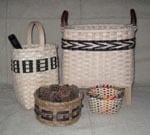THE ART OF BASKETS, GOURDS, & SOAP
Mark Smith – Broom Master
The broom makers craft is an old one which is not too common these days, but the joy or assembling a novel creation after sitting down with some string, a stick and a bit of broomcorn is enough to keep him going through even the coldest Minnesota winters. It’s just more fun to sweep up a mess or clean up a corner if the tools you are using have character and charm.
The brooms are made of harvested or downed branches or saplings and storm felled split logs (pine, birch, oak and ash). The processed broomcorn used is a traditional material identical to that produced in bulk in the Midwest USA in the later 19th century as raw material for the thriving cottage industry of broom making long before anyone had a Hoover or a Dyson for routine household cleaning. Colored nylon twine is used in tying the broomcorn and attaching it to the handle or just cinching the processed broomcorn when making smaller whisks or hearth brooms. Occasionally the broomcorn is hand dyed to add more vivid color than the natural tones or the raw wood and fiber.
In addition to the functional art that is found in the whisks, the cobweb catchers, hearth sweepers or Shaker style kitchen sweepers, Mark had also made some pieces especially for display. As an example, a well-crafted traditional wedding broom for a new couple on their special day is truly a fulfilling project well worth the extra effort. However, all of Mark’s creations qualify as “suitable for framing” and would be just as comfortable hanging on a wall for display as hard at work chasing dust and debris.
Creekside Creations
Kelcie Groth and Leslie Bouchonville starting make soap over 10 years ago. Creekside Creations is a very small business which produces only soap of the highest quality. A typical batch of soap is about 23 bars. Special attention is given to the details with each bar being wrapped in a specialty fabric for gift giving and to keep the scent fresh.












